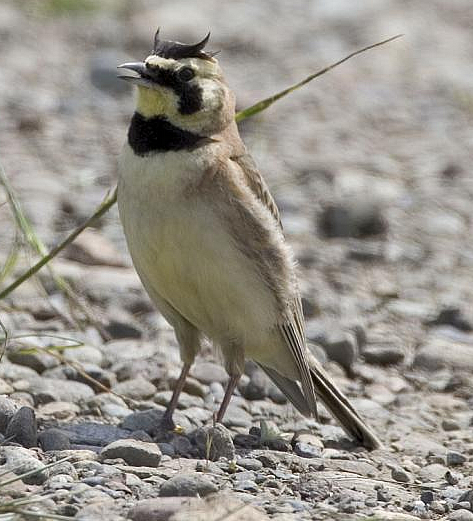August 5, 2015 — Four conservation groups filed a formal notice of intent to sue the U.S. Fish and Wildlife Service today seeking to strengthen protections for the streaked horned lark, which has lost 98 percent its grassland habitat. The lawsuit will challenge an October 2013 decision by the agency to protect the lark as “threatened” rather than the more protective “endangered” status and to exempt all agriculture, chemical spraying, and airport activities from the prohibitions of the Endangered Species Act regardless of whether they harm the lark.
FOR IMMEDIATE RELEASE
August 5, 2015
Contact:
Nick Cady, Cascadia Wildlands, (541) 434-1463, nick@cascwild.org
Noah Greenwald, Center for Biological Diversity, (503) 484-7495, ngreenwald@biologicaldiversity.org
Lawsuit Launched to Gain Stronger Protections for Northwest Bird
Gaping Loophole in Federal Protection Exempts Farming, Spraying, Airport Activities Harmful to Streaked Horned Larks in Oregon, Washington

Photo courtesy of US Fish and Wildlife
PORTLAND, Ore.— Four conservation groups filed a formal notice of intent to sue the U.S. Fish and Wildlife Service today seeking to strengthen protections for the streaked horned lark, which has lost 98 percent its grassland habitat. The lawsuit will challenge an October 2013 decision by the agency to protect the lark as “threatened” rather than the more protective “endangered” status and to exempt all agriculture, chemical spraying, and airport activities from the prohibitions of the Endangered Species Act regardless of whether they harm the lark.
“Protecting the streaked horned lark under the Endangered Species Act means nothing if all of its threats are exempted from protection,” said Noah Greenwald, endangered species director with the Center for Biological Diversity. “The lark exemption creates a loophole big enough for a combine or a 747. It seriously threatens the survival of these handsome, horned songbirds.”
Formerly a common nesting species in prairies west of the Cascade Mountains from southern British Columbia through Washington and Oregon, the lark was so abundant around Puget Sound that it was considered a nuisance by turn-of-the-century golfers. The widespread destruction of its grassland habitats, however, caused cataclysmic population declines. It has been extirpated from the San Juan Islands, northern Puget Sound, Oregon’s Rogue Valley and Canada. In Washington it currently breeds at only 10 sites, including Grays Harbor, Fort Lewis, the Olympia airport and islands in the Lower Columbia River. In Oregon it breeds in the lower Columbia River and Willamette Valley, including at the Portland, Salem, Corvallis, McMinnville and Eugene airports.
“The streaked horned lark is already gone from many of the places it used to call home and is continuing to decline,” said Andrew Hawley. “If the lark is going to have any chance at survival, it needs the full protections of the Endangered Species Act.”
The streaked horned lark is a small, ground-dwelling songbird with conspicuous feather tufts, or “horns,” on its head. Its back is heavily streaked with black, contrasting sharply with its ruddy nape and yellow underparts. They are part of a growing list of species that are imperiled by loss of prairies in the Willamette Valley and Puget Trough to urban and agricultural sprawl, including the Fender’s blue butterfly, Taylor’s checkerspot butterfly, Willamette daisy, Kincaid’s lupine and others.
“Many people don’t even know that prairies were once a common feature in both the Willamette Valley and Puget Sound,” said Nick Cady, Legal Director with Cascadia Wildlands. “If we save the lark, we are protecting an important part of the Northwest’s natural heritage.”
The groups on the lawsuit are the Cascadia Wildlands, Center for Biological Diversity, Northwest Environmental Defense Center, and Oregon Wild.
Find a copy of the Notice of Intent
here.####

